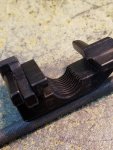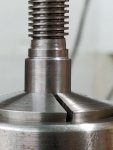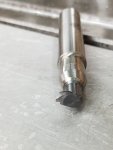Freedommachine
Active member
This is a new one for me. I have to make a replacement adjuster screw for an obsolete piece of equipment. The screw is basically a set screw with a non-standard trapezoidal thread form that looks like this:

It comes out to a 1.5mm pitch but my lathe cannot cut metric threads so thread milling is my only available option.
I picked up 3 feet of 5/8" dia O1 so I should have plenty of attempts to get the tool geometry correct. My plan is to turn the basic thread form on the lathe; cut 4 teeth into it on the mill while holding the tool in a collet block, relieve the backside of the teeth on a bench grinder and then heat treat with oxy/fuel.
What do you guys think?

It comes out to a 1.5mm pitch but my lathe cannot cut metric threads so thread milling is my only available option.
I picked up 3 feet of 5/8" dia O1 so I should have plenty of attempts to get the tool geometry correct. My plan is to turn the basic thread form on the lathe; cut 4 teeth into it on the mill while holding the tool in a collet block, relieve the backside of the teeth on a bench grinder and then heat treat with oxy/fuel.
What do you guys think?



